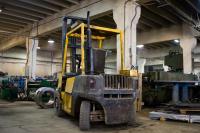 Add My Company
Add My Company
Sign In
THE AVERAGE LIFESPAN OF A FORKLIFT TRUCK
21-03-2016

When you have a fleet of forklifts purchased at different times, perhaps even by different managers, it can be difficult to know exactly when to replace your trucks. There are many factors which affect the average life span of a forklift truck, and it is important that you and your employees are aware of these criteria to ensure your fleet is as durable, safe and efficient as it can be. So what should you be looking out for?
WORKING ENVIRONMENT AND PROCESSES
If your forklifts encounter harsh environments often then this will affect their longevity. Whether operating in extreme heat or cold, in a corrosive environment of dust or water, your forklift’s lifespan will be shortened by exposure. You should also check that your truck is being used within the limits specified by the manufacturer, as putting it under undue pressure is also likely to limit its life span. A typical forklift lasts 10,000 – 20,000 hours without needing major repair, but if your truck is being used by multiple workers in harsh conditions every single day, you may need to adjust that significantly.
ROUTINE MAINTENANCE
Does your fleet have a maintenance schedule that is adhered to rigorously, or have you let it slide during busy periods? Failing to attend to minor problems can lead to major ones later down the line, and this neglectful treatment will reduce your truck’s lifespan. In addition to booking a regular servicing of your fleet you should also have your drivers conduct cursory checks before every shift. Getting into a routine of checking fluid levels and wearable items such as tires and belts leads to a more vigilant staff, which means major problems are spotted in good time.
SIGNS OF FAILURE
By maintaining a vigilant workforce you will increase your forklift’s lifespan, but only if your drivers know what to look for. Give your drivers a thorough briefing on the known signs of forklift truck failure, which include cracks or distorted parts, wiring which has become exposed, distorted or worn fork blades, and general low performance during everyday tasks.
REPAIR VS REPLACE
The main thing you’ll be considering is whether it is cheaper to continuously repair an ageing forklift, or if it is time to cut your losses and purchase a new one. By keeping a regular maintenance schedule and logging every small repair cost you’ll obtain a more accurate picture of how efficient your fleet is. You will also be able to spot any patterns in the repair log, and potentially trace any repeated repair jobs to a particular job or worker’s misuse.
Obviously it goes without saying you should also ask a more detailed version of these queries when purchasing a used forklift, because the hidden costs of a poorly maintained truck may actually outweigh the savings made from purchasing second hand. But beyond financial reasons the main motivation for attempting to calculate your forklift’s lifespan is to reduce the risk of accidents.
Stressed and damaged forklifts are not only dangerous in themselves; they can often be traced back to poor handling by their drivers, and as we’ve seen many times before this can lead to some rather nasty accidents if such behaviour isn’t nipped in the bud. If you want to prevent your forklift truck fleet from harming both your workers and your wallet, follow our advice and keep an eye on the lifespan of your fleet.
For more information on THE AVERAGE LIFESPAN OF A FORKLIFT TRUCK talk to H and F Lift Trucks
Enquire Now
More Blogs
List your company on FindTheNeedle.

